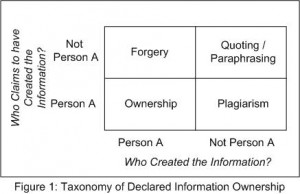Plagiarism and forgery are at opposite ends of the declared ownership spectrum. Plagiarism involves attempting to present the work of others as if it were your own. In contrast, forgery involves attempting to present your own work as if it were created by someone else. Both plagiarism and forgery are considered to be deliberate acts of deception.
Within these two extremes, further categories can be identified. For example, quoting or paraphrasing the work of another are legitimate means of expressing the ideas of someone else and acknowledging the original ownership of the ideas. Figure 1 presents a taxonomy of declared information ownership.
Replicating the work of another is established practice in some disciplines as a method of learning; for example, an apprentice may seek to reproduce an art work of their master. Deceit only arises if at a later date the ownership of the reproduction is mistakenly attributed. The difference between replication (seeking to imitate) and reproduction (following the same process) is discussed here: http://politicalsciencereplication.wordpress.com/2013/02/24/is-there-a-difference-between-replication-reproduction-and-re-analysis/
Misrepresenting information or using information created by another party without their permission contravenes the principle of information ownership. Information ownership is founded on the ethical viewpoint that the individual (or organization) creating the information (or the artefact in which the information is embedded) has the right to benefit from any financial gains arising from the information. There are alternative ethical positions, such as that the creator does not have the right to prevent others from using the information created, or that the creator should only be able to gain initial financial benefit and should not financially benefit from how the information artefact is later used.
Beyond the ethical and legal issues of information ownership lies the perceived significance of information in society. The ease with which information can be copied and falsely attributed using information technology reduces the valuable information resource to that of a disposable commodity. This requires a cultural change, which values information and the investment made by an individual or organization in creating the information, uses the information responsibly, and accurately declares information ownership.
Further Reading: information ownership is discussed in Chapter 5.
Please use the following to reference this blog post in your own work:
Cox, S. A., (2014), ‘Plagiarism and Forgery: A Taxonomy of Declared Information Ownership’, 9 May 2014, http://www.managinginformation.org/plagiarism-and-forgery/, [Date accessed: dd:mm:yy]

